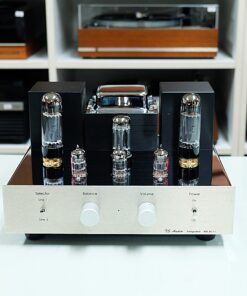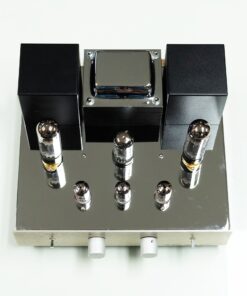Integrated Amp Elekit TU-8200 (New)
฿32,500.00
ไฟ 100 V
มีสินค้า
Elekit TU8200 Single Ended 6L6 Amplifier
Elekit TU-8200 Amplifier
8 WPC Tube Amp from Japan (2014-)
Intro Specifications Assembly Measurements
Performance Usage Recommendations More
Elekit TU-8200
Elekit TU-8200 (8 watts per channel, 14.55 lbs./6.6 kg, 65 watts idle power draw, $895 complete with tubes in kit form from Tube Depot). enlarge.
This all-content, junk-free website’s biggest source of support is when you use any of these links to my approved sources when you get anything, regardless of the country in which you live. Buy only from the approved sources I use myself for the best prices, service, return policies and selection. Thanks for your support! Ken.
Elekit TU-8200, rear
Rear, Elekit TU-8200. enlarge.
Elekit TU-8200
Back panel. bigger.
April 2015 audio reviews tube reviews headphone reviews all reviews
NEW: Why Tubes Sound Better 27 May 2015
Please help KenRockwell..com
Introduction top
Intro Specifications Assembly Measurements
Performance Usage Recommendations More
GO
Adorama pays top dollar for your used gear.
Amazon
Search all B&H
[Go]
The Elekit TU-8200 from TubeDepot is a classic single-ended class-A vacuum tube power amplifier kit. This is a semi-integrated amplifier with two or three line-level inputs, an input selector and a volume control with loads of gain; you don’t need a separate control amplifier or preamplifier unless you need more inputs (use a selector) or are stuck in the 1950s and need tape head or raw phono pickup inputs.
The TU-8200 is the best-sounding amplifier I’ve heard short of a McIntosh MC240, but most amplifiers have no sound of their own to hear. When a solid-state amp alters the sound, it’s always for the worse, while the whole point of a tube amp is the euphonic distortions it adds.
Tube amps and electronic kits were huge 50 years ago because you assemble it yourself, which is fun and saves a lot of money in the process.
While this modern kit has a solid glass-epoxy circuit board, solid-state power supply and automatic tube biasing circuits, the audio path is 100% classic vacuum tube. The three transformers (power and two output) are inside the steel case, and the driver tube heaters run on DC. There is over-current protection for the power tubes, and even they have individually FET-filtered B+ supplies.
It’s a great kit. The instructions are super clear and everything is packed logically to make finding everything super simple and fast.
This is a very high quality amplifier from Japan, loaded with very high quality domestic Japanese parts. This is a real kit from a first-world country; not offshored junk from God-knows-where. The only things that seemed not to be direct from Japan are the tubes: two from China and two Electro-Harmonix power tubes from Russia. The parts are much nicer than those included with the Heathkits and Hafler kits I built 35 years ago.
Since it’s single-ended and the bias is automatically calibrated for each output tube in real time, there is no need for matched tubes. In fact, feel free to swap the 6L6GC with KT88, 6550C, 6CA7 or EL34 and it automatically adjusts the bias for perfect operation.
It sounds great, with plenty of smooth, liquid sound against an utterly silent background. It certainly sounds like a tube amp, much cleaner and with much less tube fog than the TubeCube | 7. While the TubeCube | 7 is an inexpensive Chinese amp loaded with the classic distortions that make tubes sound like tubes and music sound great, this TU-8200 is a much higher quality product with much cleaner sound.
You could spend thousands of dollars for any of the “designed by ear” amps from random “enthusiastic audiophiles” with little to no background in electronics, but they won’t work as well over as large a variety of conditions and setups as this amplifier will. Boutique amps often do one or two things very well, but since they are designed by tweakers by chance, they very quickly fall apart if your system varies from the one used by the guy in Jerkwater who threw it together. This TU-8200 is a solid and well designed amplifier, and you’re not paying for advertising as you are with boutique amplifiers.
With 8 watts per channel it has more than enough power for desktop use. It sounds great with my B&W Matrix 805 at arms length on my desk and is silent — quieter than my professional Neumann KH 120 A monitors, for instance.
It also has plenty of power to drive my 4Ω B&W 802 Matrix Series III, especially because I biamplify them with a 150 cycle crossover to a pair of B&W ASW 850 subwoofers, and keep them close to my ears.
Tubes are microphonic and transformers sing. You’ll hear the innards of the tubes rattling as you plug in headphones, and when tested into dummy loads the transformers make some sound. This is normal for tube amps.
The circuit boards are very thick glass epoxy with very precisely drilled small holes and 70µm copper traces. The resist is thick blue. The boards are heavy because they are so thick; I’m impressed, since I’ve worked with military electronics that weren’t this thick.
The volume control is a glorious, smooth and great-tracking Japanese Alps potentiometer, and the volume knob is solid billet aluminum with a hole drilled all the way through for the index dot. This knob weighs 32.2 g (1.135 oz.).
The amplifier isn’t that heavy and has standard IEC/HP power, RCA input and 3/4″ banana output connections, so it’s easy to commute it between locations in your home. I carry mine back and forth between my desktop during the day and living room at night; it’s easy to plug it in at each location.
The speaker impedance selector is a switch, which I prefer to multiple posts because it means that my standard 3/4″ MDP banana plugs work regardless of the setting. With other amps, I’m always on the wrong tap so I can’t use standard connectors as I always can with this amp.
The whole point of this amplifier is musical enjoyment, and it does this in spades. I plug it in, and I can’t tear myself away from its mellifluous sound for hours and hours and hours. Its clean, liquid sound just won’t let me turn it off. In stark contrast to the dry, boring sound from professional monitoring equipment, the euphonic colorations added by tube power amps make everything sound smooth, sweet and spectacular. The whole point of tube amps is making music sound even better than it was recorded, which this gem does very well.
Rated Output Power, 8Ω with 6L6GC
8W + 8W in Ultra Linear mode. I use and measured this mode.
8.2W + 8.2W in Pentode mode.
4W + 4W in triode mode.
Frequency Response
12 cycles – 50 kilocycles (-3dB).
Noise
90 µV (IEC).
Tube Complement
Two 6L6GC output tubes.
KT88, 6550C, 6CA7, or EL34 also work just fine.
My kit came with 6L6EH, which is Electro-Harmonix version of the 6L6GC.
Auto biasing.
Two 12AU7 (a.k.a. ECC 82).
Inputs
Two position input selector.
Two stereo pairs of RCA jacks.
There’s also a 3.5mm jack which overrides the second pair of RCA for INPUT 2 if you prefer.
Rated Input
340 mV.
Output Topology
Ultra-linear, Pentode or Triode.
Selected with internal jumpers.
Output Taps
Two switch positions marked 4 ~ 6.3 Ω and 8 ~ 16 Ω.
Transformer taps internally marked 5 Ω and 8 Ω.
Output Connectors
Speakers
Gold-colored binding posts, which have banana jacks and are at standard 3/4″ spacing for use with standard MDP dual banana plugs.
I have to giggle; these look like they’re rated for 50 amperes, and this is an 8 watt amplifier. This kit certainly includes high quality parts.
Headphone Jack
Standard ¼”.
Disconnects speakers and connects a 15 Ω load resistor when a plug is inserted.
Headphones fed from a 90 Ω series resistance from the amplifier output.
Power Input
Standard HP (IEC320) connector.
Internally wired as you build the kit for 100V, 115 (110-120V), 200V (Japanese domestic appliance wiring) or 230V (220-240V) from 50~60 cycles.
If you move, you should be able to desolder the the connector and move it to another voltage.
Rated Power Consumption
60W with 6L6GC.
85W with KT88.
3A internal fuse.
See also Actual Power Consumption.
Size
157 x 252 x 285 millimeters HWD.
6.18 x 9.92 x 11.22 inches HWD.
Weight
14.55 lbs. (6.6 kg.), assembled.
Quality
Kit made in Japan.
Parts all appear to be first-quality Japanese parts. The volume control is a Japanese Alps.
12AU7 are from China.
6L6GC are Electro-Harmonix 6L6 EH, made in Russia.
มาเป็นคนแรกที่วิจารณ์ “Integrated Amp Elekit TU-8200 (New)” ยกเลิกการตอบ
สินค้าที่เกี่ยวข้อง
เครื่องเสียง
เครื่องเสียง
เครื่องเสียง
เครื่องเสียง
เครื่องเสียง
เครื่องเสียง
เครื่องเสียง



























รีวิว
ยังไม่มีบทวิจารณ์